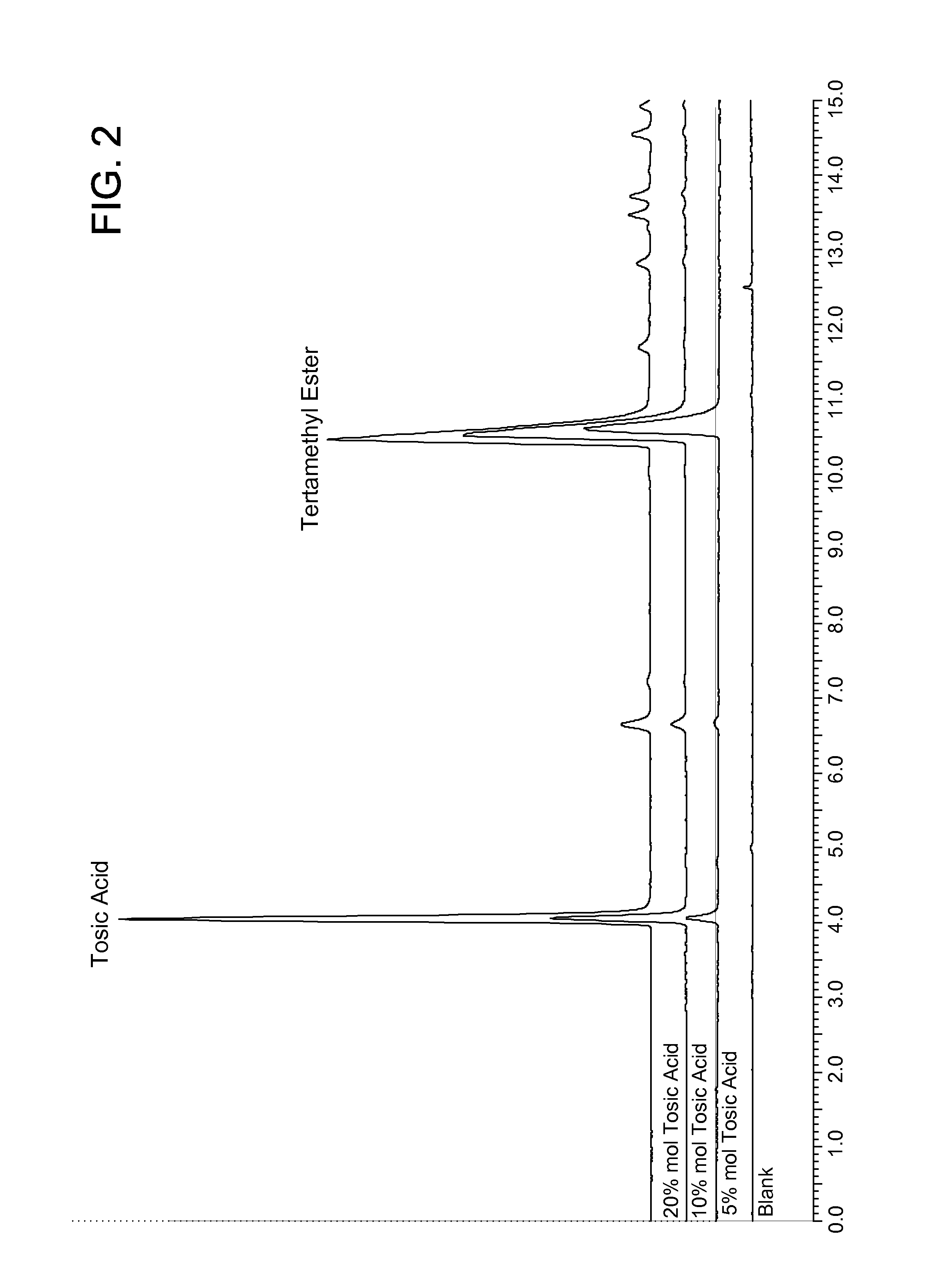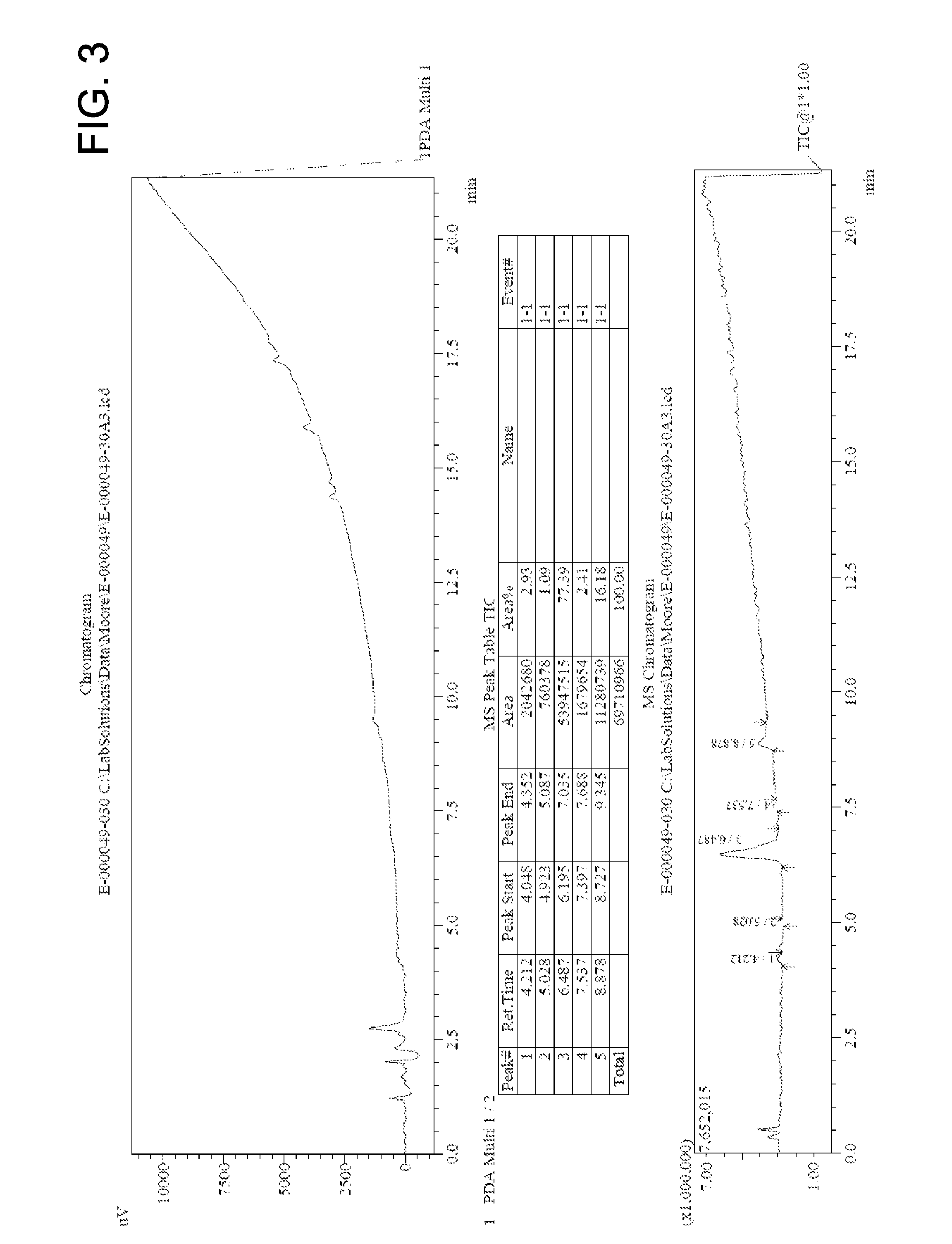Process for the preparation of macrocyclic polyazacarboxylate ligands and chelates
a macrocyclic polyazacarboxylate and ligand technology, applied in the field of macrocyclic polyazacarboxylate ligands and chelates, can solve the problems of lack of efficient and cost-effective processes for the synthesis of polyazamacrocyclic ligands
- Summary
- Abstract
- Description
- Claims
- Application Information
AI Technical Summary
Benefits of technology
Problems solved by technology
Method used
Image
Examples
example 1
Preparation of tetramethyl 2,2′,2″,2′″-(1,4,7,10-tetraazacyclododecane-1,4,7,10-tetrayl)tetraacetate (DOTA-tetra(methyl ester)) (i.e., a compound of Formula (II), wherein —R1═—CH3)
[0069]Three solutions were prepared in vials as indicated in Table 1 below, wherein the methyl 2-aziridinylacetate solution contained (20 μL, 184 mmol) methyl 2-aziridinylacetate in acetonitrile (ACN 1.8 mL) was treated with p-toluenesulfonic acid (1.48 mg, 9.21 mmol).
[0070]
TABLE 1Vial123uL of methyl 2-aziridinylacetate solution202020Millimoles of methyl 2-aziridinylacetate184184184Millimoles of p-toluenesulfonic acid9.2118.436.8Mole fraction p-toluenesulfonic acid0.050.10.2uL of 10 mg / mL p-toluenesulfonic acid solution148295590
[0071]The vials were stirred at ambient temperature for 16 hours (overnight). The reaction product was analyzed by HPLC-ELSD using a HILIC column and 85% acetonitrile (0.05% TFA) / 10% water (0.05% TFA). The chromatogram is shown in FIG. 2, indicating that 5 mol % and 10 mol % p-tolue...
example 2
Direct Formation of DOTA tetra(methyl ester)
[0072]In a 250 mL round-bottom flask methyl 2-(aziridin-1-yl)acetate (8.69 mmol) and 4-methylbenzene sulfonic acid (0.261 mmol) were combined with 50 mL methanol to give a colorless solution. The solution was refluxed under argon overnight to yield 80% yield of DOTA tetra(methyl ester). The reacted solution was analyzed by HPLC MS. The chromatogram is shown in FIG. 3, indicating that 77.4% purity of the desired tetramer was achieved.
example 3
Survey of Acid / Solvent Combinations for the Cyclotetramerization of Methyl 2-(aziridin-1-yl)acetate
[0073]A series of reactions were carried out based upon a matrix of reaction conditions consisting of four different acids (trifluoroacetic acid, p-toluene sulfonic acid, hydrochloric acid and sulfuric acid) at three different levels (2, 5, 7 mole %), four different solvents (DMAc, DMF, ACN and MeOH) at three different concentrations of methyl 2-(azridin-1-yl)acetate (5, 10, 20 uL / mL, which correspond to aziridine concentrations of 0.0414, 0.0828 and 0.166 mmol / mL, respectively). The reactions were analyzed for completeness by HPLC-ELSD using a 90-80 ACN(0.05%TFA)-Water(0.05%) gradient over 15 minutes. The results were quantified by comparing to known concentrations of DOTA-tetramethyl ester, prepared by an independent method. The results are reported in Table 2 below, wherein DMAc refers to dimethylacetamide, DMF refers to dimethylformamide, MeOH refers to methyl alcohol, ACN refers t...
PUM
| Property | Measurement | Unit |
|---|---|---|
| temperature | aaaaa | aaaaa |
| temperature | aaaaa | aaaaa |
| temperature | aaaaa | aaaaa |
Abstract
Description
Claims
Application Information
 Login to View More
Login to View More - R&D
- Intellectual Property
- Life Sciences
- Materials
- Tech Scout
- Unparalleled Data Quality
- Higher Quality Content
- 60% Fewer Hallucinations
Browse by: Latest US Patents, China's latest patents, Technical Efficacy Thesaurus, Application Domain, Technology Topic, Popular Technical Reports.
© 2025 PatSnap. All rights reserved.Legal|Privacy policy|Modern Slavery Act Transparency Statement|Sitemap|About US| Contact US: help@patsnap.com



